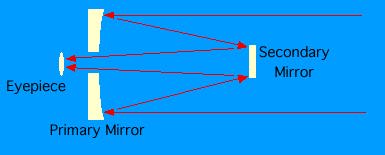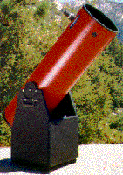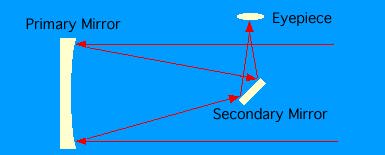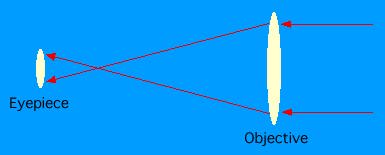Recommendation Report: First Telescope Purchase
Written by an Austin Community College student, 1999.
Purchasing a telescope can be very confusing for a person who is new to astronomy. This reports provides a comparison of entry-level telescopes for the amateur astronomer and recommends a specific type of telescope for the typical beginning astronomer. This report will focus on different types of telescopes, and not on specific brands. In addition to comparing several different types of telescopes, this report also compares different telescope mounts.
Note: This report was prepared for the Austin Telescope Society, which is a non-profit organization dedicated to the enjoyment of astronomy and the education of the public about astronomy.
Many people interested in astronomy waste money on a telescope of poor quality. A telescope in a department store may advertise that it can magnify several hundred times; however, the user is often disappointed when the image is dim, shaky, and hazy. To help avoid this confusion, it is important that the beginning astronomer understand the advantages and disadvantages of various types of telescopes. It is vitally important that the telescope have high quality optics and a sturdy mount. No extra gadgets and frills will help a telescope that has poor optics.
Definition of Terms
Before the actual comparison report, it is vital that several common terms are defined. The following terms must be understood before proceeding with this comparison:
- Alt-azimuth mount.
A type of telescope mount
that moves in two directions: altitude and azimuth.
This is the type of motion best illustrated by a cannon. It can be moved up or down, or rotated left or right. Unlike an equatorial mount, an alt-azimuth mount cannot easily track the motion of the stars through the night sky. Thus, an alt-azimuth mount is generally not suitable for astrophotography
[1:21-23].
- Aperture. The diameter of the objective lens or mirror
[2:15].
- Catadioptric. A telescope that uses both lenses and mirrors to focus light. These telescopes are often much more compact (shorter) than a standard refracting or reflecting telescope. Examples of catadioptric telescopes include Schmidt-Cassegrain and Maksutov-Cassegrain. See Figure 1 for a diagram of a Schmidt-Cassegrain catadioptric telescope
[6].

Figure 1. Diagram of the Schmidt-Cassegrain catadioptric telescope [6].
- Dobsonian mount. A type of alt-azimuth mount named after John Dobson, who invented a unique mounting design in the 1970's. John Dobson was a member of the San Francisco Sidewalk Astronomers, and he invented the mount as a sturdy and inexpensive alternative to the equatorial mount
[4:105-107].
Figure 2 illustrates a Dobsonian mount.

Figure 2. Dobsonian alt-azimuth mount [6].
- Equatorial mount.
A type of mount
that is able to track the stars through the night sky.
The mount must be aligned with the North Pole. Once aligned, the mount can easily move along the path of the stars as the earth rotates
[1:21-23].
- Eyepiece. The lens that the observer looks through to see an image. The eyepiece magnifies the light that is focused onto the focal point
[1:25].
- Focal length. The distance between the lens or mirror and the point at which light is focused. Lenses and mirrors with a strong curve will have shorter focal lengths than those that are not as curved
[2:15].
- F/ratio. A comparison of a telescope's focal length and aperture. The f/ratio is the focal length of the telescope divided by the aperture. For example, a telescope with an 8 [hyphen needed in the preceding]inch mirror and a focal length of 48 inches has an f/ratio of 6
[2:16].
- Magnification. A measure of how much an image is enlarged. For telescopes, magnification depends on the focal length of telescope and the size of the objective lens. To calculate magnification, divide the focal length of the telescope by the size of the eyepiece. For example, a telescope with a focal length of 1200 mm would have a magnification of 120 times when used with a 10 mm eyepiece
[5:74].
- Reflector. A type of telescope that uses a curved mirror to focus light onto a point. The most common form of reflector is the "Newtonian" reflector. In a Newtonian reflector, light passes all of the way down the tube onto the concave mirror. The light is then reflected back up the tube and focused onto the secondary mirror. The secondary mirror reflects the light out of the tube at a right angle and into the eyepiece
[3].
The eyepiece is actually at a right angle to the axis of the focal length of the telescope. See Figure 3 for a diagram of the reflector-type telescope.

Figure 3. Reflecting telescope [6].
- Refractor. A type of telescope that uses one or more glass lenses to bend and focus the light. Unlike a reflecting telescope, where light bounces off the surface of a mirror, light actually passes through the lenses. With a refracting telescope, the eyepiece is at the end of the telescope. This is different than a reflecting telescope, where the eyepiece is at the front of the telescope, and at a right angle to the axis of the focal length. Figure 3 illustrates a refracting telescope [6].

Figure 4. Refracting telescope [6].
Requirements for an Entry-Level Telescope
A huge variety of telescopes and features is available on the market today. It would be impossible to cover all of the models of telescopes in a single report. Many telescopes for the amateur market can cost tens of thousands of dollars. This report focuses on the needs of the beginning astronomer. Thus, those only telescope types that meet the following criteria will be compared:
- The cost of the telescope must be under $650.
- The image quality must be suitable for an amateur astronomer. Thus, the telescope must have a lens that is at least 80 mm (3 inches) for a refracting telescope or a mirror that is a least 6 inches for a reflecting telescope. Apertures smaller than this generally provide very dim images/, and are not suitable for the serious, beginning astronomer.
- The telescope must be easy to use and maintain.
- The telescope should be versatile—that is, suitable for a variety of purposes.
For this comparison, only refracting and reflecting telescopes will be examined. Catadioptric telescopes will not be reviewed, as they are generally too expensive. For example, an 8-inch Schmidt-Cassegrain telescope manufactured by Meade costs approximately $1400 [6:142].
This is well beyond the price range of $650. Most catadioptric telescopes are designed for the advanced amateur and come with a variety of accessories. This makes them generally well outside the price range of the entry-level astronomer.
Thus, five types of telescopes will be compared in this study: refracting telescopes with alt-azimuth mounts, refracting telescopes with equatorial mounts, reflecting telescopes with alt-azimuth mounts, reflecting telescopes with equatorial mounts, and reflecting telescope kits with alt-azimuth mounts. Refractors with 80-mm lenses and reflectors with 6-inch mirrors will be used for the comparison. In addition, an 8-inch Newtonian reflector on a Dobsonian mount will be evaluated. Although the 8-inch reflector on an equatorial mount is outside the price range, an 8-inch reflector on a Dobsonian mount is, in fact, under $650.
These telescopes are listed below:
- 80-mm refractor with alt-azimuth mount
- 80-mm refractor with equatorial mount
- 6-inch reflector with alt-azimuth (Dobsonian) mount
- 6-inch reflector with equatorial mount
- 6-inch reflector with Dobsonian mount (home-build kit)
- 8-inch reflector with Dobsonian mount
Comparison of Refracting and Reflecting Telescopes
The five types of telescopes chosen for this comparison in the preceding section are compared according to (1) cost, (2) magnification, (3) image quality, (4) ease of use, (5) ease of assembly and maintenance, and (6) versatility.
Cost. One of the first considerations for the purchase of a beginning telescope is the cost. With a budget of up to $650, there are several possible telescope choices. The least expensive telescope will be the Newtonian reflector kit. These kits are shipped disassembled, and the user must put them together with hand tools.
After the home-build kit, the 80-mm refractor and 6-inch reflector on alt-azimuth mounts are the next lowest in price. Depending on the manufacturer, it may be possible to find an 80 mm refractor that is actually less expensive than the 6-inch reflector. The 80-mm equatorial-mounted refractor follows behind these two telescopes.
Surprisingly, a 6-inch equatorial-mounted reflector is actually more expensive than an 8-inch reflector on a Dobsonian mount. Equatorial mounts for large, reflecting telescopes are expensive to make and to balance. They add a substantial cost to the overall price of the telescope.
Magnification. Magnification is often one of the most touted features on a telescope. However, it actually should never be considered without also considering the telescope aperture. Basically, useful magnification is limited to 50 times the aperture in inches, or 2 times the aperture in millimeters [1:19]. It is theoretically possible to magnify beyond this limit, but the image becomes extremely dim. Thus, a 60-mm refractor may be theoretically capable of 300 x magnification, but the image quality would be terrible.
Of these telescopes, the 8-inch reflecting telescope offers the greatest possible magnification. Its theoretical limit is 400 x magnification. The 6-inch telescopes are capable of 300 x magnification. The 80-mm refracting telescopes are capable of around 160 x magnification.
Image quality. Image quality is also related to aperture. A telescope with a large lens or mirror has a great deal more light-gathering ability than a telescope with a small lens or mirror. The 8-inch reflecting telescope has 70% more light-gathering ability than the 6-inch telescopes. The 80-mm telescopes do have greater optical efficiency than a reflector of the same size, but they cannot compete with the 6-inch reflecting telescopes.
Ease of use. In this category, the alt-azimuth mounts rank higher than equatorial mounts on the same telescope type. The alt-azimuth mounts provide a very intuitive interface. Much like aiming a cannon, the user moves the telescope up or down, and rotates the telescope left or right. Equatorial mounts require alignment with the North Pole, which can take up to half an hour for exact alignment.
Both of the refracting telescopes are ranked ahead of the reflecting telescopes because they are much more intuitive to use (even on an equatorial mount). Since the eyepiece is along the axis of the focal length, it is easy for the astronomer to sight along the telescope tube. All of the reflecting telescopes have an eyepiece that is at a right angle to the axis of the focal length. Even with a finder scope, this makes viewing more difficult.
The home-built kit is ranked last for ease of use because astronomer must do their own aligning on the finder scope. When first installed, a finder scope will not usually point exactly where the telescope is aiming. This is similar to adjusting the sights on a gun. This can take a considerable amount of time. Some home kits do not even come with a finder scope, which means that astronomers will have to set up "iron sights" (much like a pistol) along the tube to use for sighting. It is possible, however, to add a finder scope at a later time.
Ease of assembly and maintenance. The refracting telescopes, on either mount, win this category. The reflecting telescopes require periodic mirror adjustments. Although this is not difficult, it does require some skill on the part of the user. The home-built reflecting telescope kits come in last in this category. They require substantial set up on the part of the user. In addition, home-built kits tend to require more periodic maintenance unless the builder has done an expert job at assembling the kit.
Versatility. All of the scopes on alt-azimuth mounts have one primary disadvantage: they are not suitable for astrophotography. Because alt-azimuth mounts cannot track the motion of the stars as the earth rotates, photographs taken through them will have light trails. So, equatorial mounted telescopes of any size will win this category.
The 8-inch reflecting telescope is last in this category simply because of its size. It is much bulkier than a 6-inch telescope, and that makes it much more difficult to transport. If the astronomer has a large vehicle, such as a pickup truck, this will not be an issue.
The following table summarizes each category; lower total scores indicate better ranking:
| Category | 80-mm Alt-Az. | 80-mm Eq. | 6-in Dobs. | 6-in Eq. | 6-in Home | 8-in Dobs. |
|---|---|---|---|---|---|---|
| Cost | 3 | 4 | 2 | 6 | 1 | 5 |
| Cost/Aperture | 5 | 6 | 3 | 4 | 1 | 2 |
| Magnification | 5 | 5 | 2 | 2 | 2 | 1 |
| Image Quality | 5 | 5 | 2 | 2 | 2 | 1 |
| Ease of Use | 1 | 2 | 3 | 5 | 6 | 3 |
| Ease of Assem. | 1 | 1 | 3 | 3 | 6 | 3 |
| Versatility | 3 | 1 | 4 | 1 | 4 | 6 |
| Price | $360 | $400 | $350 | $640 | $300 | $500 |
| Totals | 23 | 24 | 19 | 23 | 22 | 21 |
Conclusions
- All six of these telescopes are fairly close in price. Of these telescopes, the 8-inch reflector offers the greatest light-gathering ability.
- The 8-inch mirror has 70% more surface area than a 6-inch mirror. However, it is somewhat bulkier than the other telescopes, which makes it somewhat less versatile.
- The 6-inch telescope kit offers the greatest value as far as cost-to-aperture ratio is concerned. However, kits require a great deal of time and effort and may not be suitable for the average beginner. An astronomer comfortable with home projects will probably want to consider a kit thoughin that it does offer a substantial value.
- When it comes to overall aperture, the reflecting telescopes are easily able to outperform similarly priced refracting telescopes. High magnification is a factor with deep space objects. It is not as great a factor for planetary observations. The astronomer should keep in mind the intended use of the telescope when making a purchasing decision.
- Equatorial mounts add a great deal of cost to a telescope. This fact is especially true when dealing with a large, bulky telescope. Unless astrophotography will be a requirement of the user, it is much cheaper to go with a sturdy, dependable alt-azimuth mount. The Dobsonian mount is an excellent choice for the reflecting telescopes, as it is extremely sturdy and easy to handle.
- All of the reflecting telescopes will require more maintenance than the equivalent refractors. However, the mirror adjustments are usually minor, and the user should be able to learn the maintenance procedures fairly easily. Any hobbyist that is uncomfortable with performing maintenance procedures may wish to opt for a refracting telescope.
Recommendations
After weighing all of the factors in the comparison, I find that the Newtonian reflecting telescope on a Dobsonian mount provides the best value for the beginning astronomer. Although this type of telescope can be built at home, it is recommended that a pre-made telescope be purchased. A pre-made telescope has much lower initial maintenance requirements and is easier to set up. Of the reflecting telescopes, the 6-inch reflector provides the best compromise between light-gathering ability and cost. A 6-inch Newtonian reflector on a Dobsonian mount is an excellent entry for any astronomer, and the telescopes can be purchased for around $350. For about $150 more, it is possible to purchase an 8-inch Newtonian reflector. Many beginning astronomers may want to consider spending the extra money if they feel that they will stay with the hobby for some time.
If a beginner is seriously interested in astrophotography, an 80-mm refractor on an equatorial mount is recommended. The equatorial mount is required for astrophotography, and an 80-mm refracting telescope will still keep the cost low enough for the beginner.
Sources
- Miller, Robert. Making & Enjoying Telescopes. New York: Sterling, 1997.
- Berry, Richard. Build Your Own Telescope. Richmond, VA: Willmann-Bell, 1994.
- Bishop, Dennis and Bob Martino. "Purchasing Amateur Telescopes." Perkins Observatory. 1996. (7 July 1998).
- Berry, R. "Telescope-Making Revolution." Astronomy (August, 1998), 105-109.
- Jones, Brian. Practical Astronomer. New York: Simon & Schuster, 1990.
- Martino, Bob. Perkins Observatory. bmartino@osu.edu.
- Meade Instruments Corporation. Meade Telescopes. Product Brochure. N. d.
Programs and information provided by admin@mcmassociates.io.